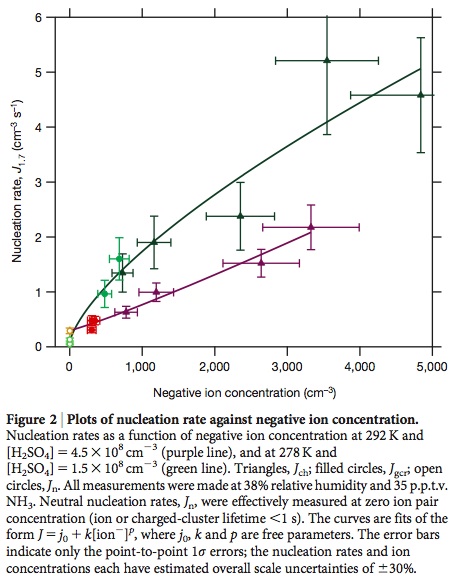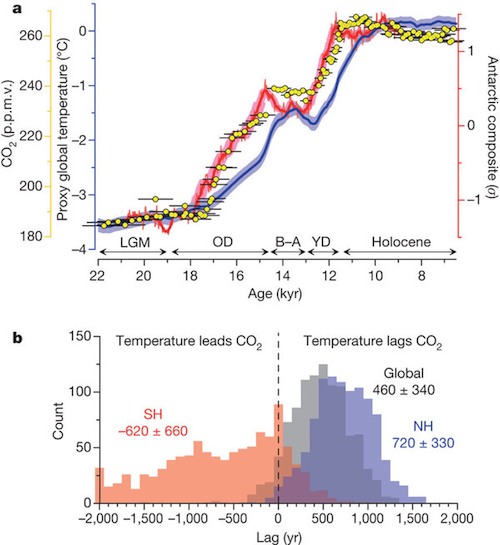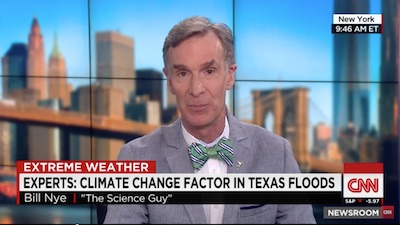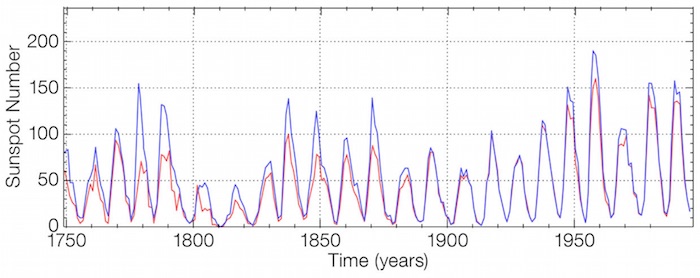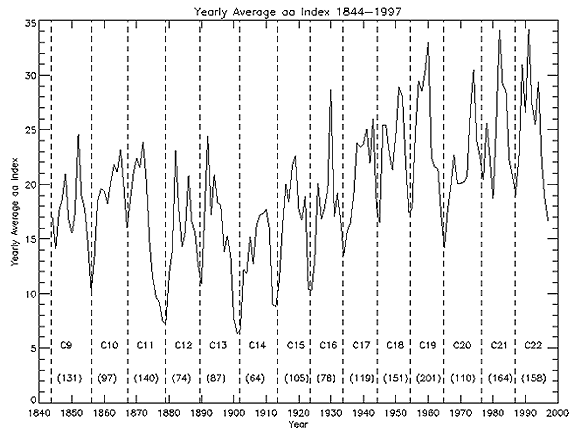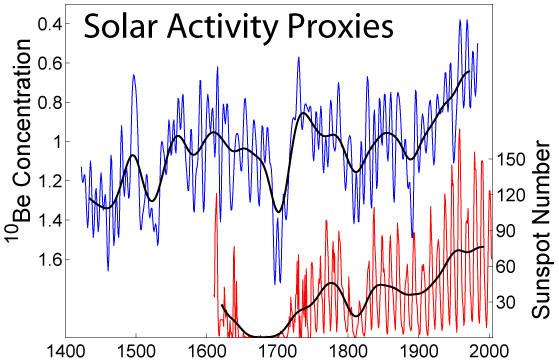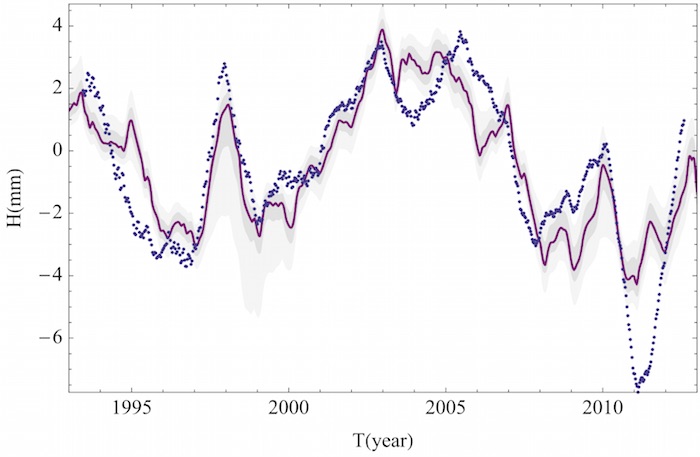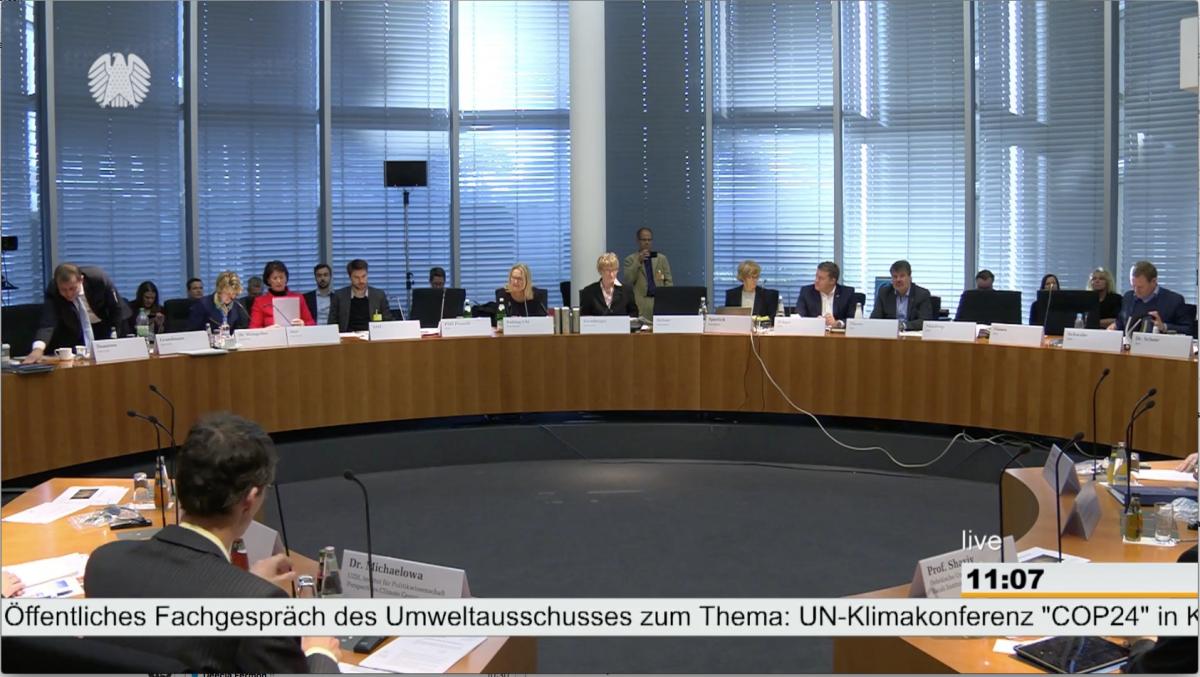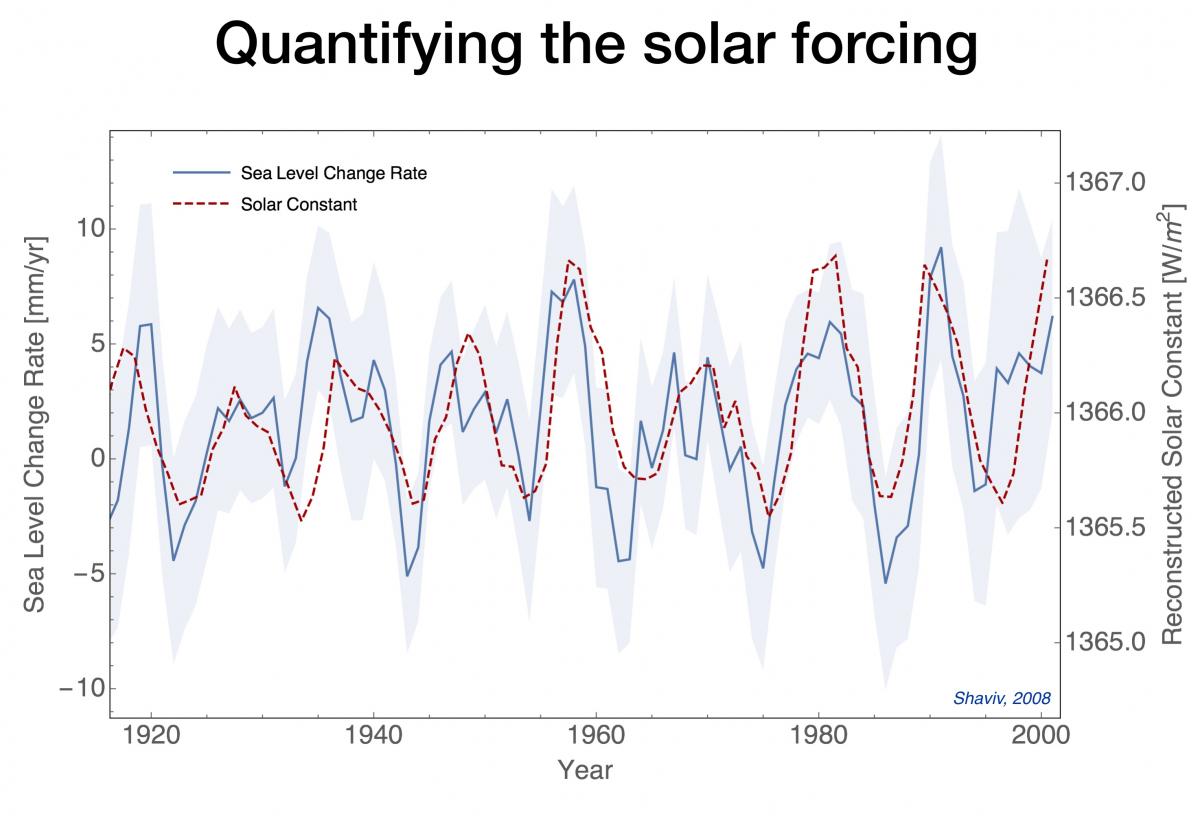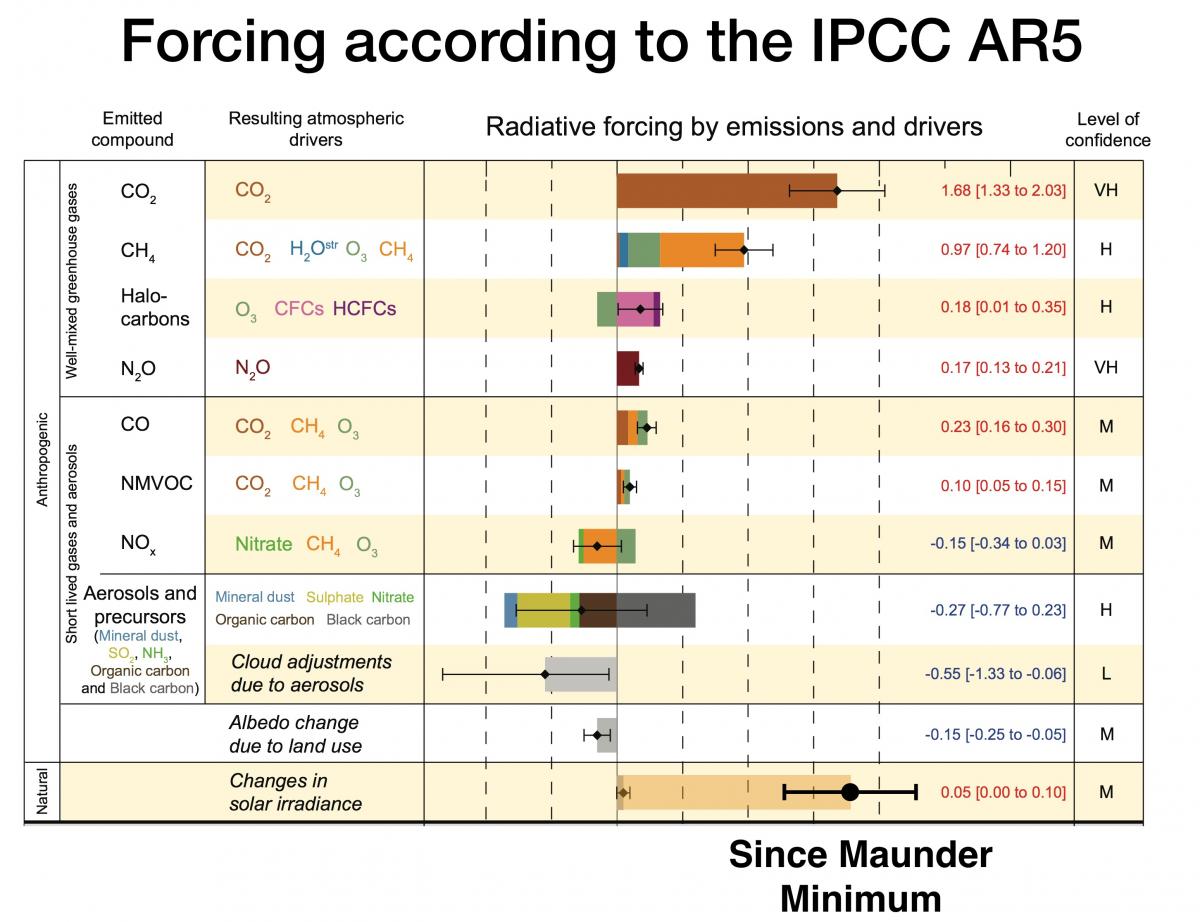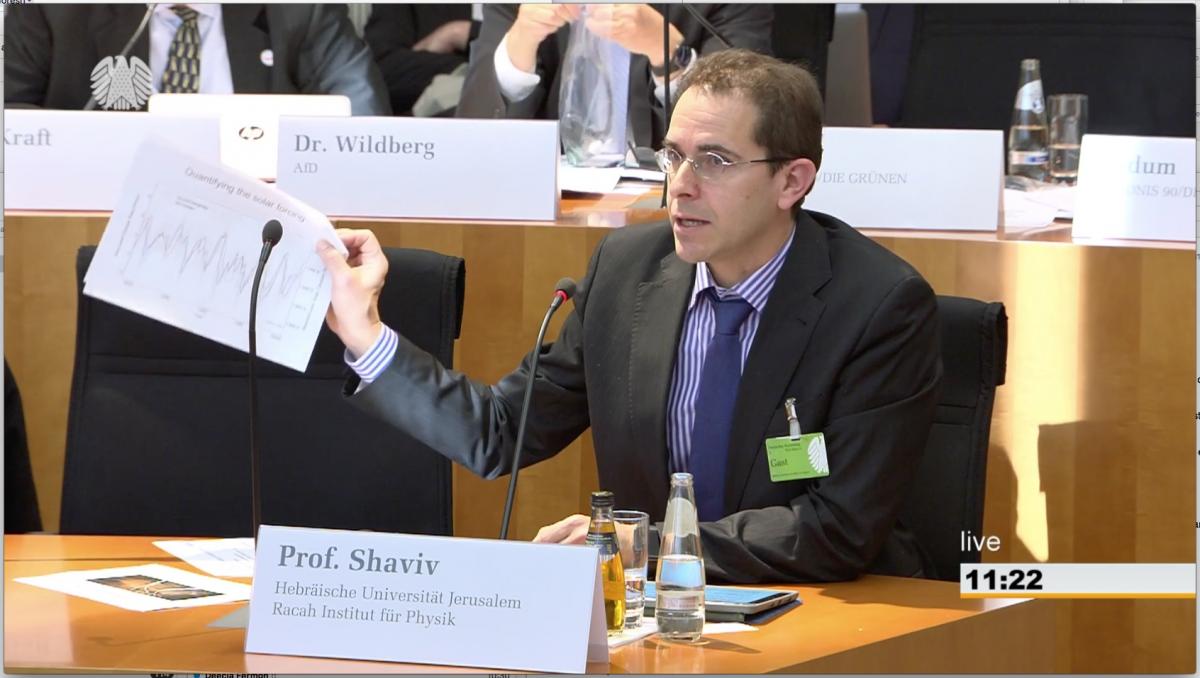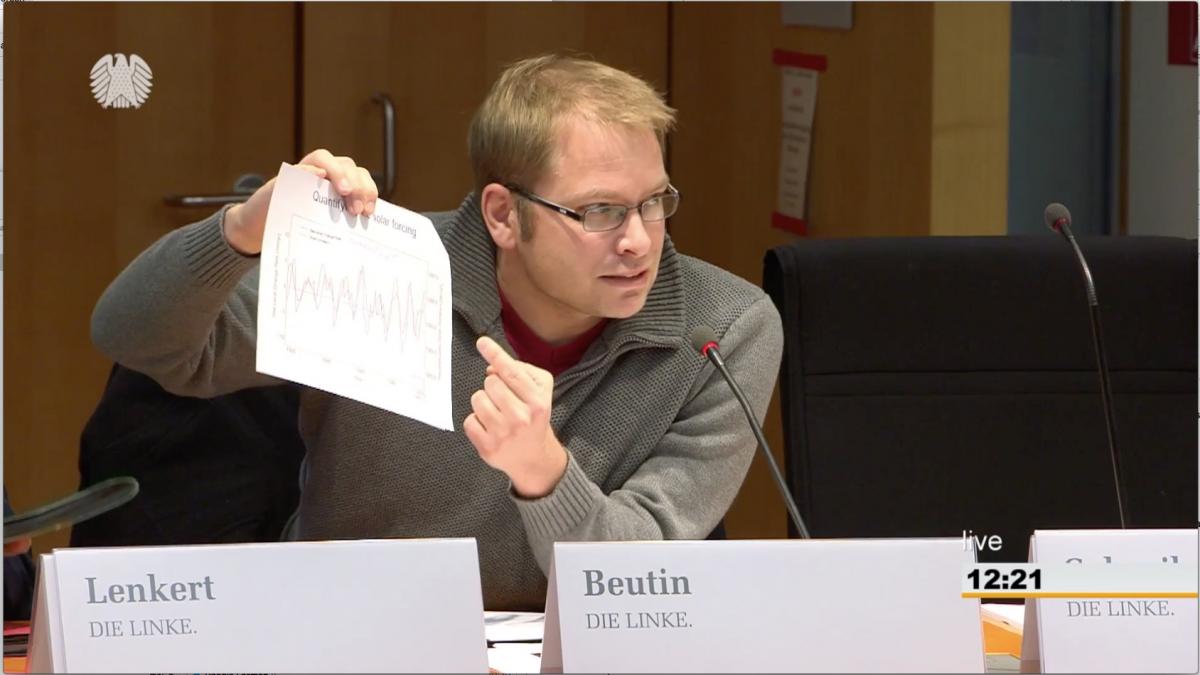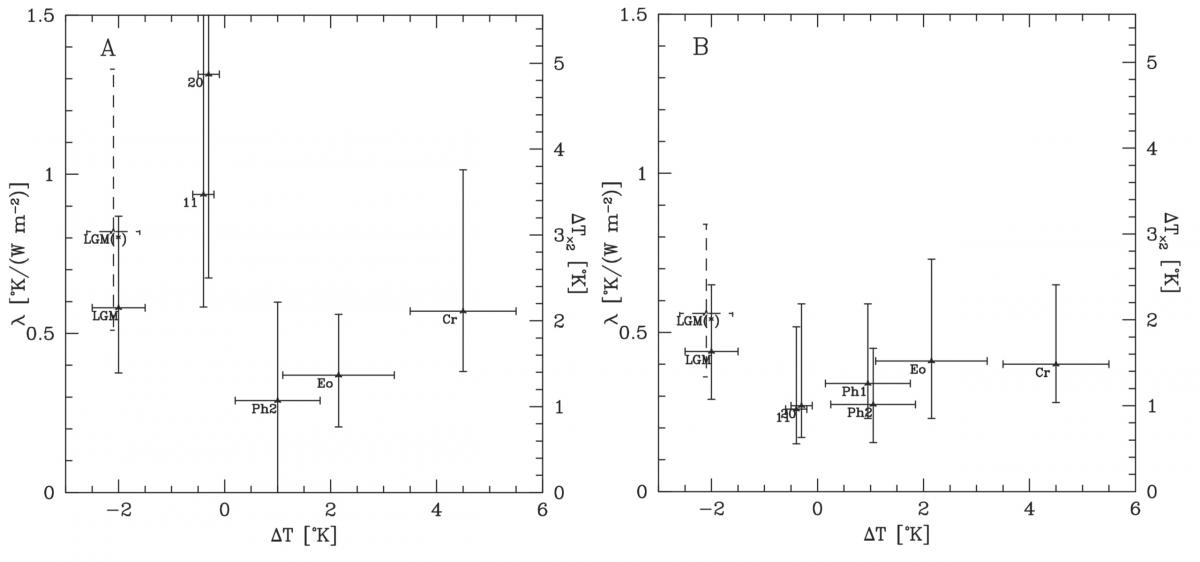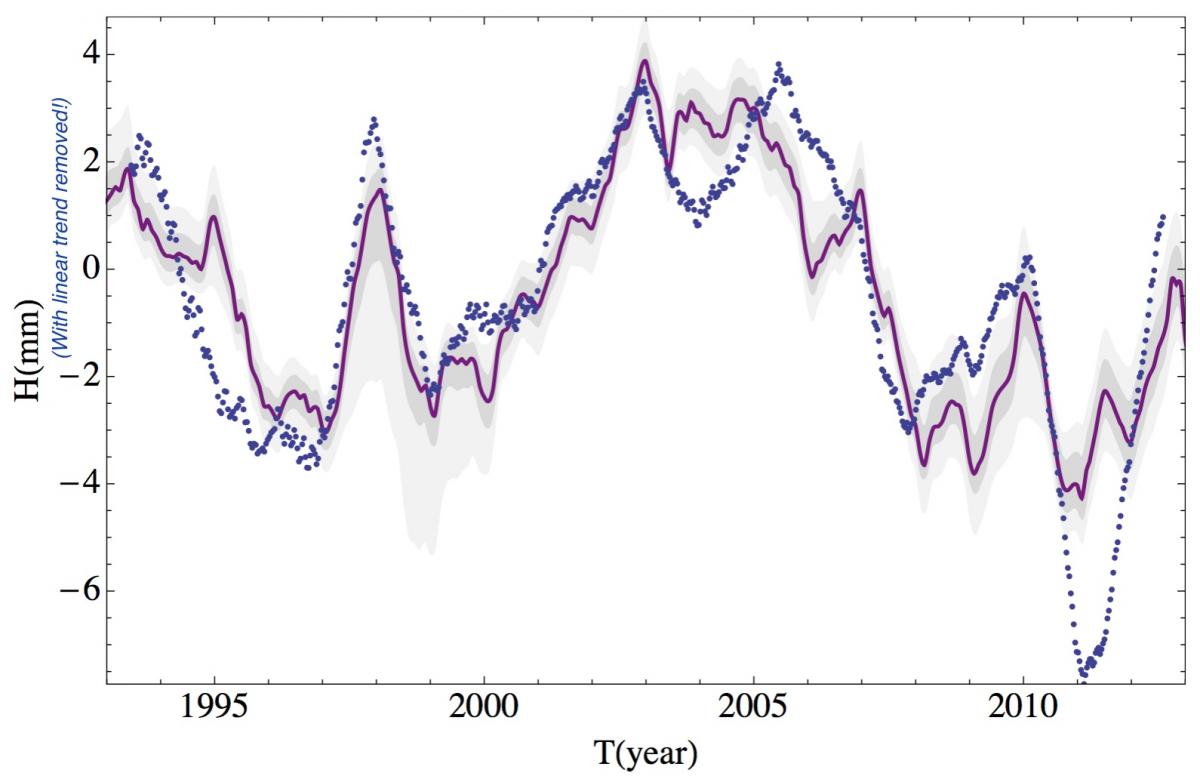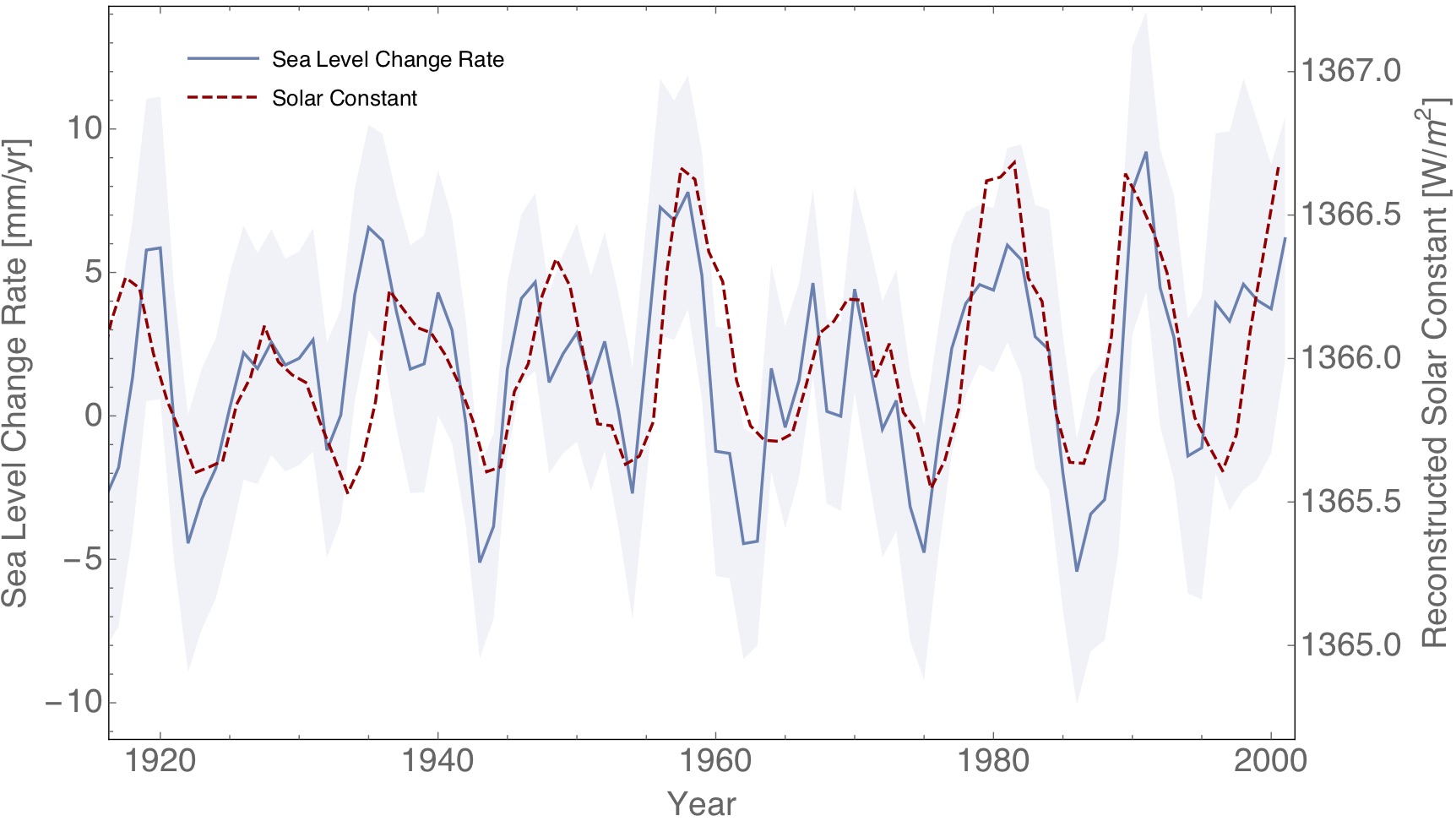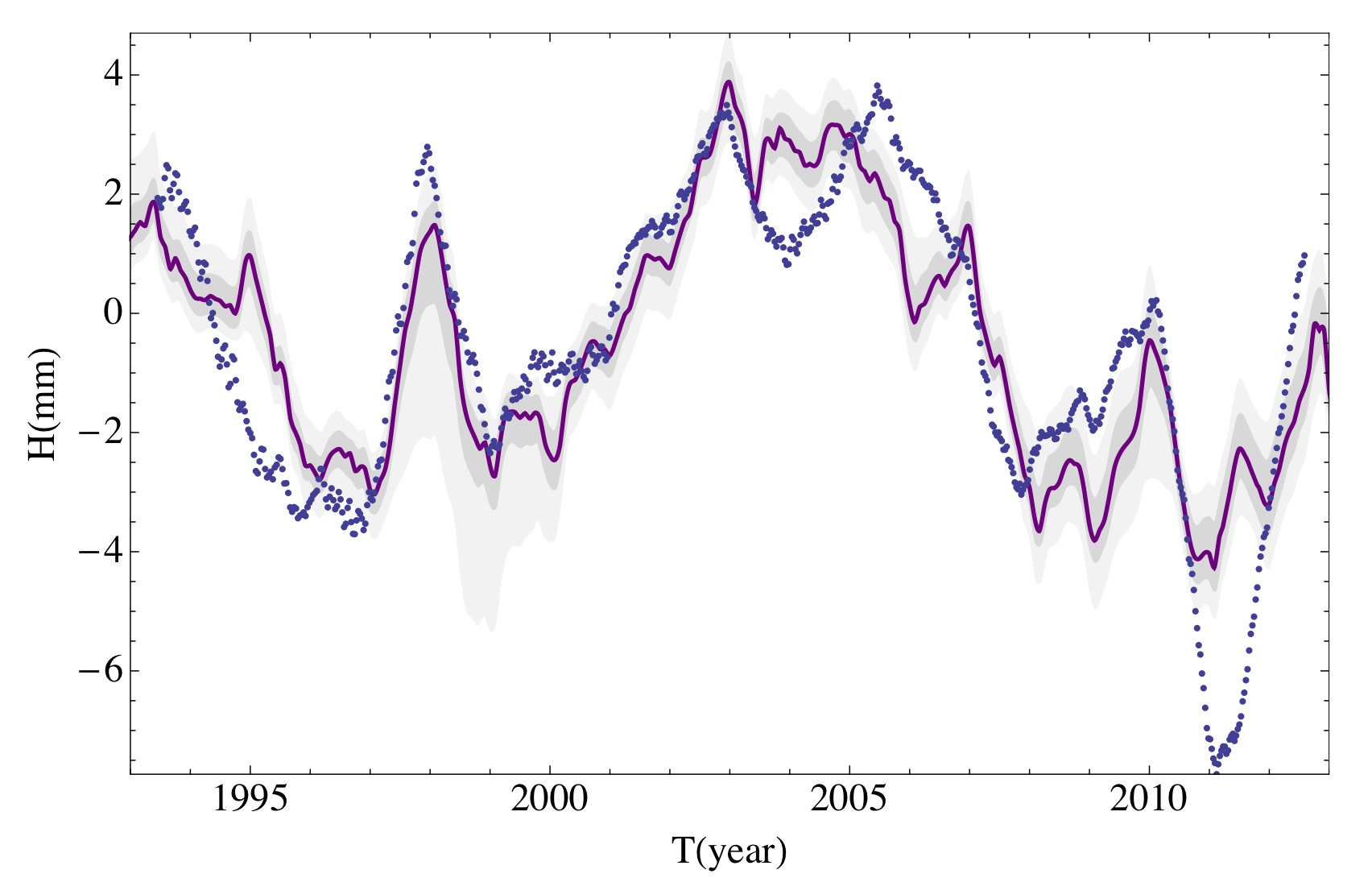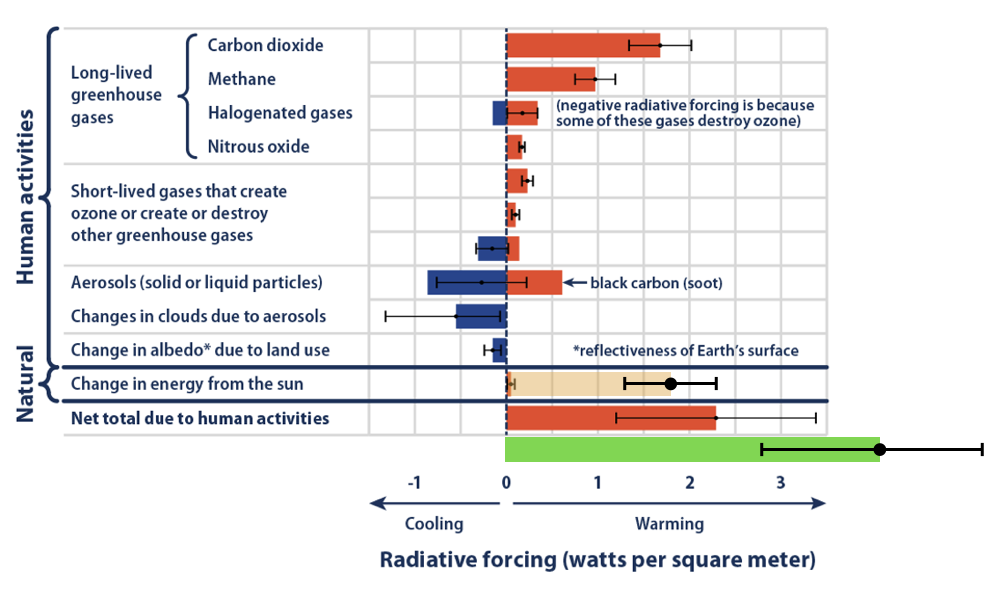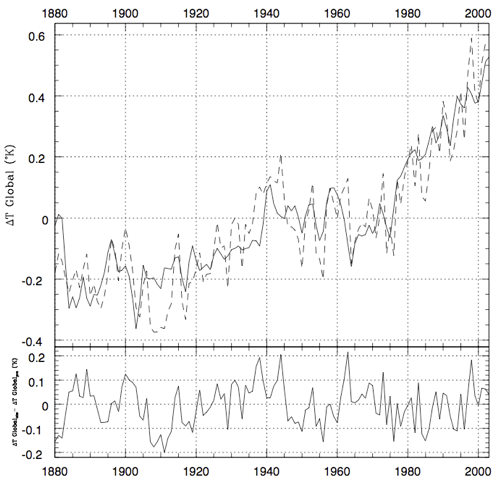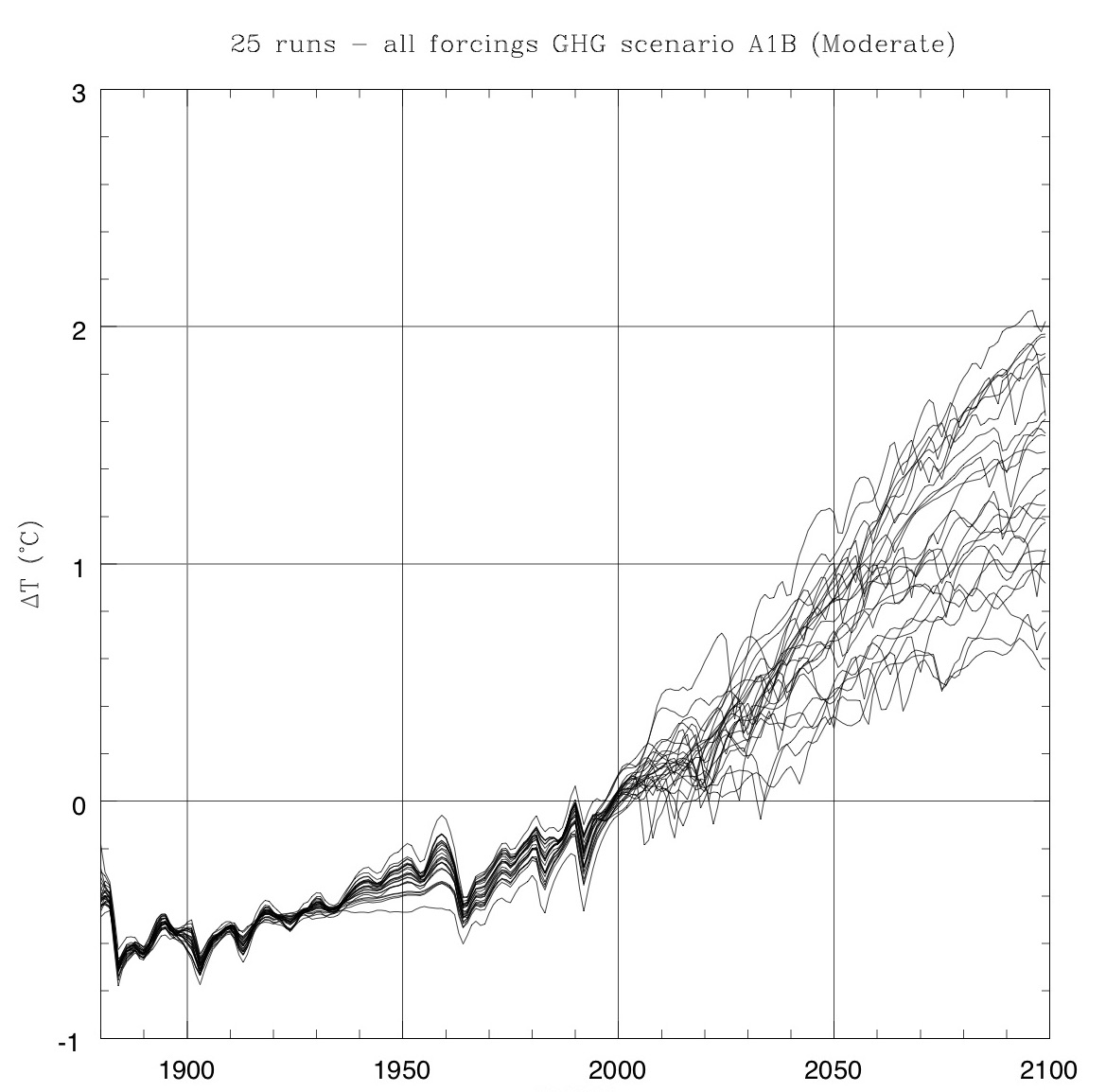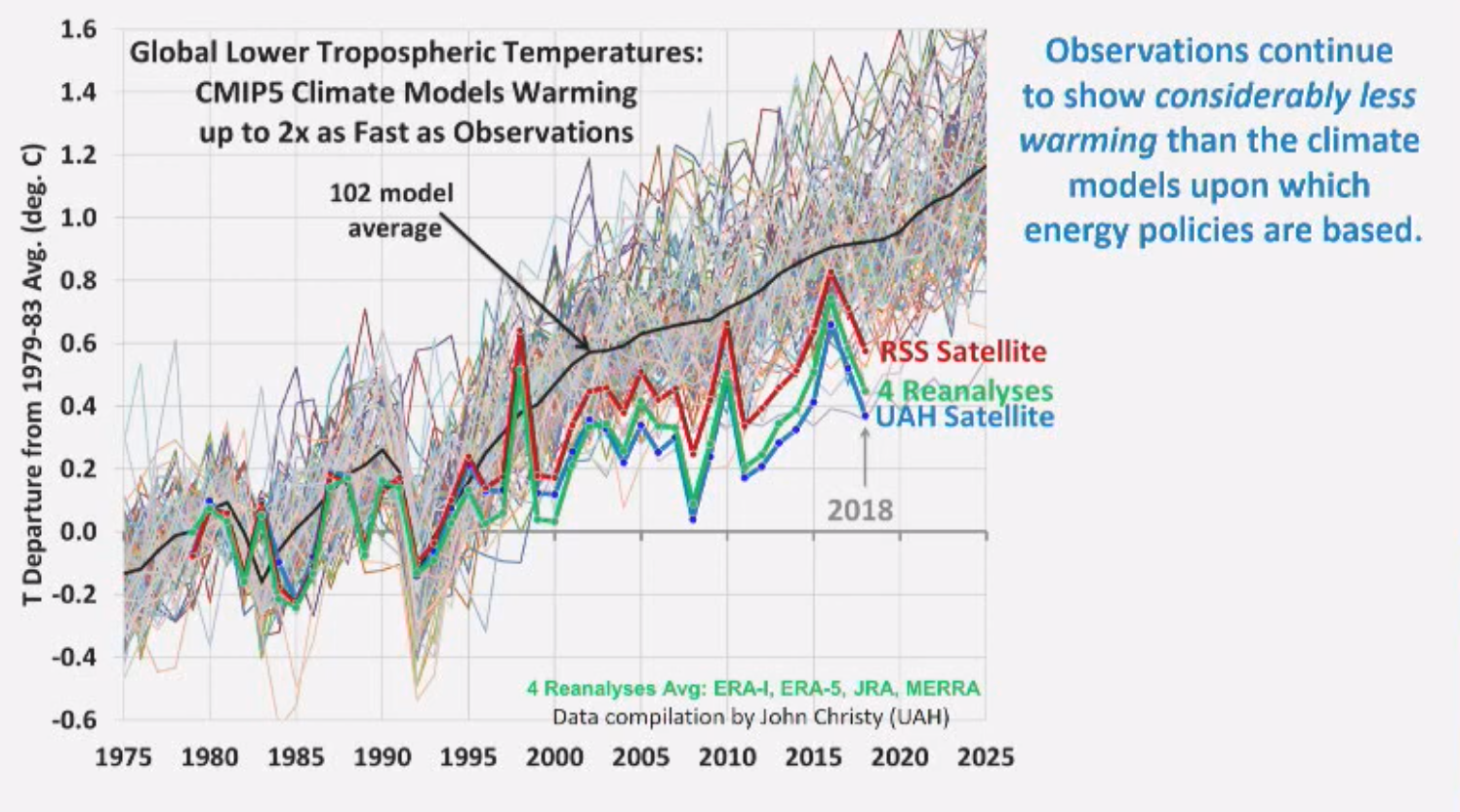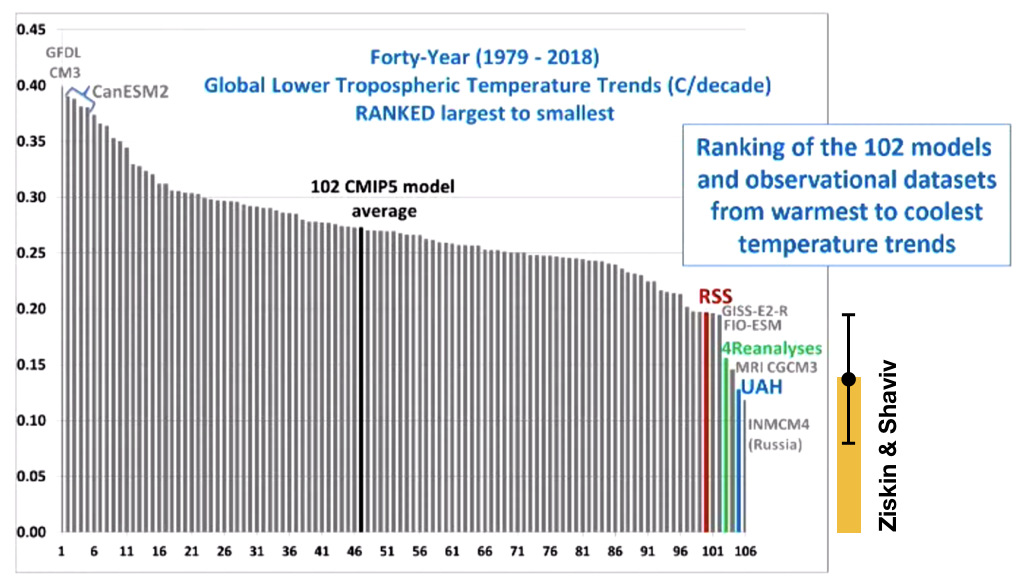Back to Part IICosmic Rays and Climate
The second type of mechanisms is indirect, through the solar modulation of the cosmic ray flux and the effect that the latter may have on the climate. Cosmic rays are high energy particles (primarily protons) which appear to originate from supernova remnants (the leftovers from the explosive death of massive stars). A possible climatic link through cosmic rays was first suggested by Edward Ney already in 1959. It was well known that the solar wind decreases the flux of these high energy particles and that these particles are the primary source of ionization in the troposphere (which is the lower part of the atmosphere). Ney proposed that the changing levels of ionization can play some climatic role.
In the 1970's, Robert Dickenson proposed the possibility that the atmospheric ion density could play a role in the formation of cloud condensation nuclei. When air reaches saturation, that is, 100% humidity, the preferred equilibrium state is that of liquid water. However, if the water vapor has nothing to condense upon, it will not do so. In fact, under very clean environments, it is possible to reach 400% humidity before the vapor condenses spontaneously. In order to get clouds at 100%, as we see in nature, we need cloud condensation nuclei (CCNs). Over land, there are many natural sources for CCNs, however, this is not the case over the oceans, were the CCNs must be grown out of something. Dickenson suggested that this growth process of CCNs could be affected by the amount of atmospheric charge.
In the 1990's, Henrik Svensmark and his colleagues found empirically that clouds, and in particular low altitude clouds, appear to vary in sync with the solar activity (see fig. 6). The change in the energy budget associated with this change in the cloud cover is consistent with the amount of heat we find enters the oceans every solar cycle.
[collapse title="Figure 6"]
![]()
Figure 6: The correlation between cosmic ray flux (orange) as measured in neutron count monitors in low magnetic latitudes, and the low altitude cloud cover (blue) using ISCCP satellite data set, following Marsh & Svensmark (JGR, 108 (D6), 6, 2003).
[/collapse]
Since Svensmark’s work, more evidence was found to support this link, the full picture of which is the following. When the sun is more active, it has a stronger solar wind. The stronger wind slows the cosmic rays as they propagate into the inner solar system. As a consequence, the amount of atmospheric ionization is reduced. Less ions reduce the efficiency with which new cloud condensation nuclei can grow, especially over the oceans, such that the clouds that later form have fewer but larger droplets. These clouds are less white, they reflect sunlight less efficiently and therefore cause more warming.
[collapse title="Figure 7"]
![]()
Figure 7: The cosmic ray link between solar activity and the terrestrial climate. The changing solar activity is responsible for a varying solar wind. A stronger wind will reduce the flux of cosmic ray reaching Earth, since a larger amount of energy is lost as they propagate up the solar wind. The cosmic rays themselves come from outside the solar system (cosmic rays with energies below the "knee" at 10
15eV, are most likely accelerated by supernova remnants). Since cosmic rays dominate the tropospheric ionization, an increased solar activity will translate into a reduced ionization, and empirically (as shown below), also to a reduced low altitude cloud cover. Since low altitude clouds have a net cooling effect (their "whiteness" is more important than their "blanket" effect), increased solar activity implies a warmer climate. Intrinsic cosmic ray flux variations will have a similar effect, one however, which is unrelated to solar activity variations.
[/collapse]
The evidence to this particular link comes from experimental results and from correlations between independent cosmic ray flux variations and climate changes on different time scale.
Just by itself, a cosmic ray climate correlation over the 11-year solar cycle does not necessarily imply a causal link. One could imagine that the solar activity affects both the cosmic ray flux and the climate, making it appear that there is a causal relation between the latter two. Nevertheless, there are indications that it is not just an apparent link. For example, the dependence of the relative cloud cover variations with the magnetic latitude is the same as the latitudinal dependence of the relative change in the atmospheric ionization, over the solar cycle. Another important fact is that the full solar cycle is not that of 11-years, but 22-years instead. It takes 11-years for the magnetic field to flip, but 22-years for it to return to the original state. However, all the solar activity proxies are “blind” to the polarity of the magnetic field, all except the cosmic ray flux which exhibits a clear asymmetry between odd and even solar cycles. This asymmetry is seen in the change of the low altitude cloud cover, implying that the cloud cover variations originate from cosmic ray flux variations.
On short time scales, the sun can undergo flaring activity which is caused from the reconnection of magnetic loops. These flare are accompanied by a strong solar wind “gust” which later causes a decrease in the cosmic ray flux for several days. If the cosmic ray flux has an effect on clouds, then cloud properties should change following these events, known also as Forbush decreases. Several results indicate that clouds are affected during Forbush decreases. In particular, recent results by Bondo et al. have shown the cosmic ray mechanism at work. Not only was a cloud signal observed, the intermediate step of affecting the aerosol size distributed was detected as well.
Over longer time scales, of decades to millennia, there are the aforementioned solar climate links, however, even though they demonstrate a clear causal link between solar activity and climate change, it is hard to prove with them that this link is specifically due to solar modulation of the cosmic ray flux. If we however go to longer time scale still, there is evidence from cosmic ray flux variations which are not associated with solar activity.
On the time scale of tens of thousands of years, Earth’s magnetic field varies and with it the flux of cosmic rays which can penetrate the atmosphere. Because however the magnetic field can only prevent the penetration of cosmic rays which are anyway severely attenuated by the atmosphere, changing the magnetic field, and even altogether switching it off is not expected to give rise to significant climate effects. A rough estimate gives that switching the magnetic field will only cool the Earth by typically 1°C. However, over the time scale that the magnetic field changes, Earth witnesses variations which are 5 times larger from other natural causes. That is, it is not easy to detect the terrestrial field effects, but they were claimed to be detected nonetheless.
Over geological time scale, the cosmic ray flux changes because of our motion around the Milky Way and the changing solar neighborhood. Because the cosmic ray flux originates from the death of the short living massive stars, in events called supernovae, passage through regions with a higher star formation rate is associated with an elevated cosmic ray flux level. The largest variations actually originate from the solar system's passage through the milky way spiral arms.
As it turns out, it is possible to reconstruct the changes in the cosmic ray flux originating from these passages, using iron meteorites. This reconstructed flux shows variations by as much as a factor of 3 between the flux between the spiral arms and the flux in them. And indeed, when the global climate is studied over this time scale, it is possible to see all the past seven passages of the solar system through the arms of the galaxy over the past billion years. Every spiral arm passage, the increased cosmic ray flux manifested itself as a cold epoch during which Earth's poles are glaciated. In between the arms, it was much warmer than the present climate.
[collapse title="Figure 8"]
![]()
Figure 8: An iron meteorite. A large sample of these can be used to reconstruct the past cosmic ray flux variations. The reconstructed signal reveals a 145 Million year periodicity. The meteorite in the picture is part of the Sikhote Alin meteorite that fell over Siberia in the middle of the 20
th century. The cosmic-ray exposure age of the meteorite implies that it broke off its parent body about 300 Million years ago.
[/collapse]
[collapse title="Figure 9"]
![]()
Figure 9: The correlation between the cosmic ray flux reconstruction (based on the exposure ages of Iron meteorites) and the geochemically reconstructed tropical temperature. The comparison between the two reconstructions reveals the dominant role of cosmic rays and the galactic “geography” as a climate driver over geological time scales. (Shaviv & Vezier GSA Today 13, No. 7, 4, 2003)
[/collapse]
In addition to the empirical evidence, an experiment was carried out by Svensmark's group. This experiment was carried out to simulate marine air conditions and study how the changed atmospheric ionization affects the growth of condensation nuclei under controlled laboratory conditions. The experiment demonstrated that elevated ionization rates give rise to a more efficient formation of condensation nuclei. Today, this experiment is carried out in a mine in the UK to see how the total removal of ions affect the formation of condensation nuclei, and also at CERN, to corroborate the effects of ionization, this time with high energy particle ionization as opposed to UV.
[collapse title="Figure 10"]
![]()
Figure 10: The Danish National Space Center SKY reaction chamber experiment. The experiment was built with the goal of pinning down the microphysics behind the cosmic ray/cloud cover link found through various empirical correlations. From left to right: Nigel Marsh, Jan Veizer, Henrik Svensmark. [/collapse]
And the forecast?
The fact that the sun plays a decisive role in climate change has important implications to the understanding of the causes of 20
th century global warming and the expected temperature change in the coming century. The increased solar activity over the 20
th century can be translated into a radiative forcing contribution. Since the solar/climate link was already quantified, it is possible to estimate the solar contribution, which turns out to be about half of the measured warming.
Thus, the warming component left to be explained by humans is much smaller than is often claimed by the proponents of the anthropogenic warming. However, if we are to predict the temperature change over the 21
st century, we have to know what is the expected human contribution to the radiative budget, but equally important, also the climate sensitivity to these changes in the energy budget.
As we have seen above, the answer to the second question is that the sensitivity is most likely small. In fact, this sensitivity is about 1 degree increase per doubling of CO
2. When answering the first question, we have to make a distinction between natural causes, such as solar activity, cosmic ray flux variations and volcanic activity, and between human activity.
Unfortunately, it is impossible to predict most of the natural variations. We have no tools with which we can predict when a volcano will erupt, nor can we predict how solar activity will vary from one solar cycle to the next. All that can be done is to estimate the probability for different variations based on historic changes. Regarding solar activity, we can see for example that over the past several thousand years, solar activity did not rise significantly above its levels over the latter half of the 20
th century. Therefore, we can expect, with reasonable confidence, that solar activity will diminish over the 21
st century, and cause a temperature decrease of several tenths of a degree.
It is also impossible to predict human activity. At most, we can estimate it. The IPCC published several scenarios describing how human activity is expected to increase and with it, how the amount of atmospheric CO
2 is expected to rise, under several different sets of assumptions, for example, according to how fast humanity will switch to alternative energy sources.
Under pessimistic scenarios of “business as usual”, we see that doubling the amount of CO
2 over the 21
st century is a realistic possibility. However, given the low climate sensitivity, we can expect a total increase of about 1 degree from such a pessimistic scenario. This is similar in size to the natural variations Earth has witnessed over the past several millennia. For comparison, the doomsdays scenarios we hear about daily talk about increases of typically between 3 to 5°C.
The evidence shows therefore that even if we continue with “business as usual”, we will not cause a climate catastrophe. It is also possible to estimate the sea level increase, which will be of order 10 cm over the coming century, much less than the meters talked about in Gore's movie.
An optimist’s note
At this point, I would like to make a personal note. Perhaps I am an optimist, but I think that the likelihood that our economies will rely on fossil fuels several decades into the future is relatively small. If we would have been asked a century ago what would life be at the beginning of the 21
st century, we would not have been able to think about the existence of computers, mobile phones, nuclear reactors, spaceships, the internet or even seemingly trivial things such as plastic or coke with artificial sweeteners. The speed with which technology advances is so rapid, that in the not so distance future we will have cheaper energy sources than coal and oil, based perhaps on organic based photovoltaic cells, nuclear fusion, or energy sources based on a yet to be discovered technology. Thus, it would be naive on our part to even try to predict how much CO
2 we will emit in the coming century.
Secondly, I am not the enemy of the environment movement. I believe that humans should take full responsibility over their activity and the damage they inflict on the environment. However, I claim that global warming is not a real issue. The are many pressing problems which do deserve our immediate attention, which because of global warming are neglected. Many people with good intentions are acting out of emotion and gut feeling, not out of reason, and as a result, they waste precious resources without doing any substantial good.
And now for the really last point. Don’t believe a word I write. If you are a genuine scientist, or wish to think like one, you should base your beliefs on facts you see and scrutinize for yourself. On the same token, do not blindly believe the climate alarmists. In particular, be ready to ask deep questions. Does the evidence you are shown prove the points that are being made? Is the evidence reliable? Sometimes you'll be amazed from the answers you find.
Let me end with a few millennia old quote often attributed to king Solomon, and which I find most appropriate:
"מה שהיה הוא שיהיה, ומה שנעשה הוא שיעשה ואין כל חדש תחת השמש"קהלת א'פסוק ט'.
“What has been will be again and what has been done will be done again and there is nothing new under the sun”.
Qohelet (Ecclesiastes 1:9).






